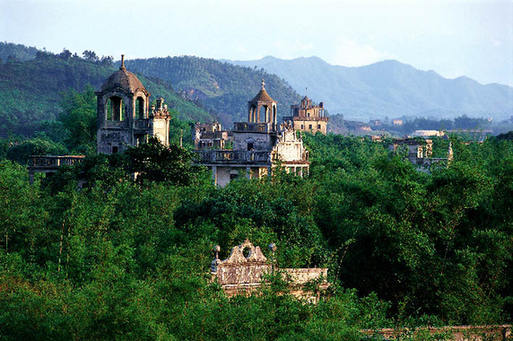| Jiangmen Dreamland
By WU MEILING
AT the very spot where the Xijiang and Pengjiang rivers converge, with Yandun and Penglai mountains either side, Jiangmen has savored its fame for ages.
Unlike the rapid and disorienting economic growth of Zhuhai and Shenzhen, the development of Jiangmen has been steady and sure, pacing consistently towards its destiny as an ecologically advanced city. In terms of comprehensive economic ratings, it is already in China's top 50. Jiangmen has several other national laurels to wear, among them Gardening City, Sanitarily Model City, and the Best Tourism Destination.
Its history goes back to 219 BC, when the army of the First Emperor of Qin took south China and established Nanhai Prefecture in this region. Presently, it has seven sub-administrative districts.
Apart from its uncompromised economic progress, Jiangmen's long list of attractions are topped by its uniqueness. World famous buildings called "diaolou," or highly unusual blockhouses, are found in the region , and its waterways and wetlands are a paradise for birds.
 |
| The blockhouses of Kaiping. |
Blockhouses of Kaiping
In the mid-19th century, many people from Jiangmen migrated to Canada, the U.S, and Australia for the "gold rush," railway building, or similar purposes that called for massive infusions of labor. If you ask contemporary overseas Chinese where their hometown is, this place is one of the four most often cited in response. The air of American and Canadian "Chinatowns" is even today dominated by Jiangmen dialects. Reciprocally, these pioneers brought back to China the Western culture and lifestyle they practiced, which in turn gave birth to unique residential constructions, including diaolou blockhouses.
Over 3,000 blockhouses stand in Kaiping, one of the administrative areas under Jiangmen. The number was much greater years ago – close to 10,000. These unusual dwellings have made Jiangmen the only place in Guangdong Province on the World Cultural Heritage list.
Of all the tower residences in Kai-ping, Liyuan Garden is probably the most luxurious and impressive. Completed in 1936 after ten years of construction and refinement, it became the pride and joy of its owner Xie Weili, an overseas Chinese settled in the United States. The garden, offspring of a joyous union of Chinese and Western cultures, incorporates traditional Chinese landscaping, water gardens, and a cluster of Western-style villas. Xie had dreamed of a garden with pavilions, towers, winding brooks and ornate stone bridges like those found in China's Suzhou, but all rendered into a Western architectural form. Only Xie, with his poetic temperament and familiarity with the classics, could make this happen.
Amazingly, the garden houses a huge Italian style aviary. The four characters bai niao gui chao, or, one hundred birds return home, are still visible on it today. The aviary was a gift for Xie's fourth wife Guan, a bird lover who reportedly kept it lively with species of various kinds.
|
